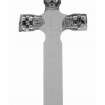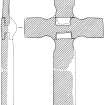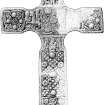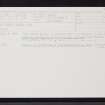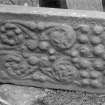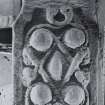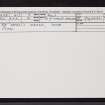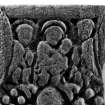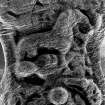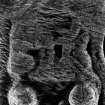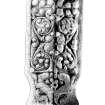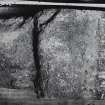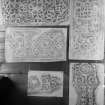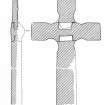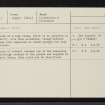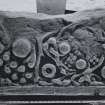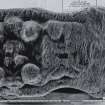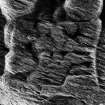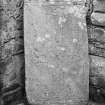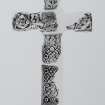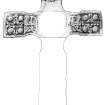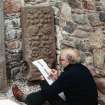Iona, St Oran's Cross
Cross (Early Medieval)
Site Name Iona, St Oran's Cross
Classification Cross (Early Medieval)
Canmore ID 21656
Site Number NM22SE 4.07
NGR NM 286 244
Datum OSGB36 - NGR
Permalink http://canmore.org.uk/site/21656
- Council Argyll And Bute
- Parish Kilfinichen And Kilvickeon
- Former Region Strathclyde
- Former District Argyll And Bute
- Former County Argyll
NM22SE 4.7 c.286 244.
Fragments of a high cross, which it is proposed to call "St Oran's", have been assembled, though whether this cross was ever completed or stood upright for very long is uncertain.
A C Thomas 1957
Field Visit (9 June 1972)
Fragments of several crosses are in the Monastery Museum and although several of the pieces are reputed to be of St Oran's Cross, they could not be identified.
Visited by OS (RD) 9 June 1972
Field Visit (September 1980)
St Oran's Cross.
The mutilated remains of this massive ringless cross, now displayed in the Nunnery Museum, were recorded in the late 19th century as being in St Oran's Chapel, and its present designation was suggested by R B K Stevenson. The surviving upper part of the shaft, now broken into two fragments measuring 1·82m in combined length, has at the top a tenon 0·37m wide and 0.14m high, which fitted into a mortice in the underside of a transom, now also broken, having a span of 1·99m. A second mortice in the upper side of the transom held the top arm, 1·09m in height and having a tenon 0·36m wide and 0·17m high, the overall height of the surviving part of the cross being about 3·45m. The original width of the shaft, which is damaged at the right edge and displays no perceptible taper, was about 0.55m, and the width of the arms is 0.51m. The armpits of the cross-head are almost fully semicircular, having a diameter of 0·44m. Whereas the shaft, including its tenon , has split longitudinally so that only one carved face is preserved, the cross-head is entire in thickness, although heavily abraded in parts. the upper and side-arms taper considerably from the centre, where the maximum thickness preserved is about 0·24m, towards their extremities where the thickness is about 0.11 m.
The material used for the shaft is a flaggy mica-granulite of reddish-grey colour. This stone is comparatively c1ose grained, and permitted carving of some refinement, but was fatally susceptible to lamination. The transom and upper arm are carved from a foliated gametiferous mica-schist, silver-grey in colour and providing a coarse material for the sculptor. Both of these stone-types are similar to the schists of Moine age found in the Ross of Mull, a few kilometres E of Iona.
It is suggested on pp. 17-18 that this is the earliest of the Iona group of crosses, dating probably from about the middle or the second half of the 8th century.
See RCAHMS 1982 pp.192-7 for a full illustrated description.
RCAHMS 1982, visited September 1980
Reference (2001)
(Iona 80) ST ORAN'S CROSS. Recumbent in Abbey Museum; formerly in St Oran's Chapel. Fragments of a massive cross, 3.45m in surviving height and 1.99m in span, with 0.44m semicircular armpits. The top arm and shaft (whose surviving part is broken across and split in thickness) were tenoned into a transom which is broken at the centre. The shaft is of mica-granulite and the arms of a coarser mica-schist, both from the Ross of Mull. On the front (a), within a 40mm interlaced border, the shaft bears two cruciform groups of bosses, some of bird's-nest type, divided by rows of small bosses in saltire. In a panel below this and in the side-arms the same motif is combined with snakes. At the top of the shaft are the Virgin and Child between two angels whose inner wings form a canopy. The centre of the cross-head showed five bosses and to the left is a figure standing beside a leonine beast but not in conflict with it, perhaps Daniel rather than David. The right constriction is lost but in the upper one is a symmetrical pair of beasts, each with a smaller companion. The top arm bears a rich composition of spiral bosses of varying size, including four roundels which generate serpents with gaping jaws. On the back (b) each of the side-arms bears a cruciform pattern of spiral bosses diverging from four larger bosses. In the left constriction is a cloaked and seated harper, and to the right an enthroned figure facing a standing one, perhaps with a halo (? Christ and Pilate). The top arm bears six large bosses producing serpents with gaping jaws, four of which threaten a ?human head.
I Fisher 2001.
External Reference (28 October 2011)
Scheduled as element within 'The monument known as St Mary's Abbey, Iona, monastic settlement [comprising] the remains of the large early historic monastic settlement founded by St Columba in AD 563, St Martin's Cross, and parts of medieval buildings associated with the Benedictine Abbey of St Mary founded around AD 1200.'
Information from Historic Scotland, scheduling document dated 28 October 2011.































